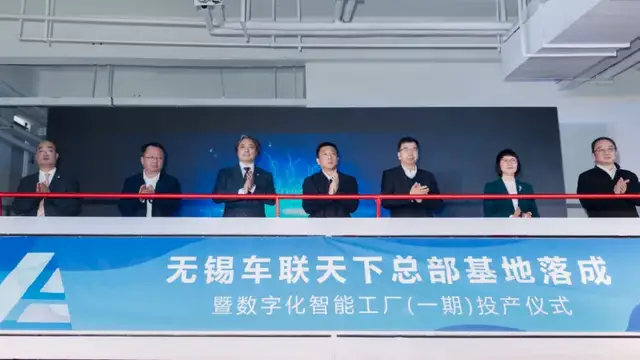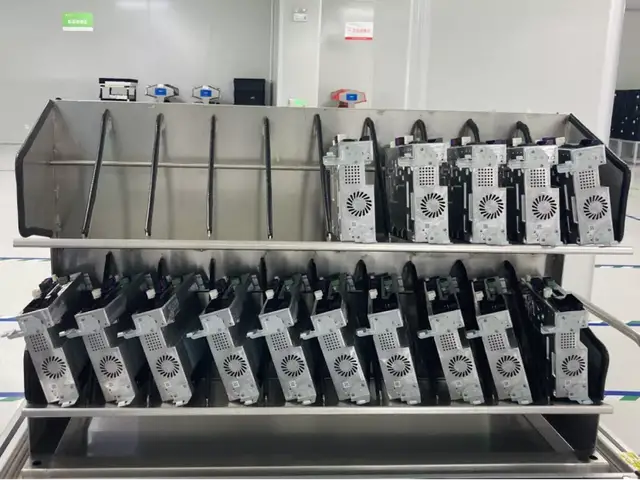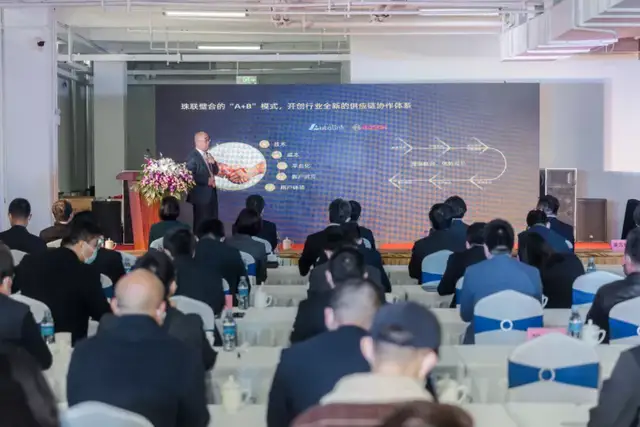On December 21, Wuxi Autolink Information Technology Co., Ltd. (Autolink) held a ceremony to inaugurate its headquarters base and put its digital smart factory into production in Wuxi.
Founded in August 2014, Autolink integrates Internet of Vehicles products, design, R&D, sales, services and operations, helping automakers provide users with intelligent hardware (cockpit), software (smart assistant) and operation services. It is currently an emerging company in the cockpit domain controller field. In December 2020, Autolink moved from Beijing and Shenzhen to Wuxi and settled in Wuxi Economic and Technological Development Zone.
On April 2, 2021, AutoLink, Bosch and Qualcomm teamed up to complete the development and mass production of the world's first single-chip, dual-system, multi-terminal smart cockpit domain controller on Great Wall Motors.
So far, in addition to Great Wall, AutoLink and Bosch have also won 8,155 cockpit domain control orders from many automobile companies including GAC Trumpchi, GAC Aion, Chery Automobile, Geely Automobile, and Changan Automobile.
One is the world's largest automotive technology supplier with a 135-year history, and the other is an emerging local company that has only been established for 7 years. How did they come together?

“A+B” cooperation model
In 2014, Yang Hongze founded Autolink, which initially produced traditional automotive electronic products such as digital instruments. After five years, he realized that there was no future in the industry, saying, “It’s not a red ocean, it’s a purple ocean.”
In 2019, after a thorough investigation of the development of the vehicle's electronic architecture and intelligent connected technology, Yang Hongze decided to significantly cut traditional businesses, abandoning traditional distributed products such as the LCD instrument assembly, central control navigation assembly, and T-Box, and began to think about making the next generation of smart cockpit controllers.
While Yang Hongze was looking for a way out, Bosch was also making adjustments internally. Bosch Automotive Multimedia Division cut off traditional products such as T-Box, car computers, and instruments, and turned its focus to smart cockpits. On July 31, 2019, the Future Cockpit (Shanghai) Technology Center of Bosch Automotive Multimedia Division was completed and put into use in Zhangjiang, Pudong, focusing on the research and development of products in the field of smart cockpits.
It was at the Zhangjiang Technology Center opening ceremony that Yang Hongze met Li Yin, president of Bosch Automotive Multimedia Division Asia Pacific, who was looking for a smart cockpit partner for Bosch in the Chinese market. The two sides quickly hit it off and reached a consensus on cooperation within three or four months.
Why did Bosch choose Autolink when it was looking for a local partner?
Li Yin explained: "Software-based products have two characteristics: first, they are highly localized; second, they are iteratively fast." Therefore, the partners Bosch chooses must first have an understanding of the Chinese market and second, be able to accelerate the iteration of Bosch software. More importantly, in the words of Yang Hongze, chairman of Autolink, "both parties have an absolute consensus on the direction and path of future smart cockpit development."
In April 2020, Bosch and Autolink jointly won Great Wall's intelligent cockpit domain control project and signed a 15-month development and supply agreement with Great Wall for mass production and delivery.
OEMs have an increasing demand for intelligent automotive functions. In order to better respond to this demand, Bosch's Cross-Domain Computing Solutions (XC) Division was established on January 1, 2021. Li Yin serves as the president of the division in China.
Li Yun said that with the trend of software-defined cars and the evolution of automotive electronic and electrical architecture in recent years, "our technology has been ahead of the organization", and problems naturally arise. OEMs often raise demands, and the responsibilities between business units within Bosch are not very clear. Sometimes several business units respond to the same demand, and sometimes there is no time to respond to the same demand.
Thus, the Bosch XC Division came into being, which was formed by integrating the electronic and software businesses of Bosch's driving assistance, autonomous driving, automotive multimedia, powertrain and body electronic systems divisions.
The establishment of the XC Division is a positive response of the century-old auto parts giant to the intelligent transformation of automobiles. Currently, the XC Division has 18,000 employees worldwide, about 11,000 employees in China, and the entire division has an annual sales volume of nearly 5 billion euros worldwide.
After the establishment of Bosch XC Division, the cooperation between Bosch and AutoChina has also achieved new results.
On May 2, 2021, the world's first smart cockpit domain controller equipped with Qualcomm 8155 chip rolled off the production line and was installed on vehicles at the AutoLink factory, and formal mass production was achieved in June.
In more than a year, the East China R&D team of Autolink has grown from more than 20 people to more than 200 people. At the same time, Autolink and Bosch's engineering team have completed the difficult but important joint development model construction.
In this "A+B" cooperation model, Bosch is mainly responsible for platform-based and standardized technologies, providing the intelligent cockpit domain controller technology platform, while Chelian Tianxia is mainly responsible for the improvement of customization, personalization, customerization and service. In Yang Hongze's words, this kind of cooperation is not a combination of the strong and the weak, but a complementary combination.
The price that Chelian Tianxia paid for choosing to enter the smart cockpit domain controller track two years ago was that its annual sales revenue plummeted from nearly 700 million yuan in 2018 to 400 million yuan in 2019 and 200 million yuan in 2020, but in return it got a ticket to the future.

Next year's revenue is expected to reach 1.6 billion yuan
With the advent of the domain control era, a sizable incremental market is emerging in the automotive cockpit field. According to ICVTank data, global shipments of smart cockpit domain controllers were 400,000 sets in 2019, which will reach 2.4 million sets in 2021 and is expected to climb to 13 million sets in 2025.
In the Chinese market, the growth rate of smart cockpits is faster than that of the global market. This is because Chinese local automobile companies are leading in the exploration of smart cockpit-related technologies, products and business models. This is an opportunity for Bosch in the Chinese market and also an opportunity for the connected car world.
After the establishment of Chelian Tianxia, it received angel round financing from Qin Zhi, the former CEO of Autohome, Qin Lihong, the co-founder of NIO, and others in 2015, and received A round investment from Wingtech Technology, Huachuang Capital, Tsinghua Research Capital, etc. in 2016, and B round financing from NIO Capital, NavInfo, etc. in 2017. These rounds of financing are still investments in its traditional automotive electronics business. After entering the smart cockpit domain control track, in 2020, Chelian Tianxia received B+ round financing from Taihu Guolian, Xinshang Capital, etc.; in 2021, Weifu High-Tech participated in the C round of financing of Chelian Tianxia with 150 million yuan and Bosch with 100 million yuan.
In December 2021, the production line of fully automatic vehicle domain controller of Chelian Tianxia was completed and put into production. The first phase of three production lines has a production capacity of 900,000 units and is expected to reach full capacity in June 2022; the second phase of five production lines has a production capacity of 1.5 million units and will be officially launched in July 2022.
Liang Guofeng, CEO of Autolink, said at the factory commissioning ceremony that the revenue brought by Autolink's cockpit products will reach 220 million yuan in 2021, 1.6 billion yuan in 2022, and grow to 6 billion yuan in 2025. In five years, the cumulative delivery volume will exceed 6 million sets, with cumulative revenue exceeding 15 billion yuan.
Chen Yudong, president of Bosch China, who came to support Autolink, said that the annual revenue target of 1.6 billion yuan in 2022 was too low, and both parties should strive to achieve 2 billion yuan.
Currently, AI chip companies, software suppliers, Tier 1 system integrators, vehicle manufacturers and other forces have joined in the upgrade of domain controllers. Domain control has changed the ecology of the automotive industry. The cooperation model between Autolink and Bosch has created a new supply chain collaboration system in the industry.
Bosch is estimated to have a Tier 2 supplier business worth 3 to 4 billion euros worldwide, but the relationship between Bosch and Autolink is not a simple Tier 2 to Tier 1 relationship. Li Yin told Auto Business Review: "We are only Tier 1 to Tier 2 in terms of business, that is, in terms of payment and invoicing procedures. But in terms of real business cooperation, we are actually a community."
Liang Guofeng said that there were many conflicts in the cooperation with Bosch, such as various requirements from customers on delivery time and progress, but both sides moved forward while solving problems.
On August 18, 2021, China Automotive Industry Corporation and Bosch signed a strategic cooperation and investment agreement in Shanghai, taking the cooperation between the two parties to a higher level.
In the future, Bosch will continue to optimize and improve the performance of the underlying software of the smart cockpit. Autolink is accelerating the enrichment of the upper-layer application ecosystem to enhance the consumer experience. In the era of smart cars, they follow the trend and make their own choices.
Previous article:What is the next generation of in-vehicle display technology? Micro-LED is worth looking forward to
Next article:What is a "flexible invisible large screen"? Looking ahead to the next generation of automotive cockpit technology
Recommended posts
- 14 "Wanli" Raspberry Pi car - motor drive learning
- TheRaspberryPimotordriverexpansionboardusesthePCA9685chip,whichisanI2Cto16-channelPWMchip,andthenuses8ofthePWMstocontrolfourAT8236chips,whichisamotordriverchip.Thatis,theRaspberryPiindirectlycontrolsthe
-
lb8820265
 Innovation Lab
Innovation Lab
- Capacitive touch sensing solution based on STM8 series 8-bit general-purpose MCU
- Comparedwithmechanicalbuttonsandresistivetouchbuttons,capacitivetouchbuttonsarenotonlydurable,low-cost,simpleandeasytoinstall,waterproofandanti-fouling,butalsoprovidefunctionssuchasrollersandsliders.However,capaci
-
Aguilera
 Microcontroller MCU
Microcontroller MCU
- Please explain the assembly program of digital voltmeter
- Iamanovicewhohasjuststartedtolearn51single-chipmicrocomputers.Recently,Ihavereadtheassemblyprogramofdigitalvoltmeters,andIdon’tquiteunderstandthefunctionsofsomeoftheinstructions.Ihopethatexpertscangivemesome
-
许老二
 MCU
MCU
- 2022 Digi-Key Innovation Design Competition Participation Award Review + STM32F7508 Discovery
- 2022Digi-KeyInnovationDesignCompetitionParticipationAwardList It’simportanttoparticipate,like HowmanymetersdoIneedtosticktothisboard?
-
donatello1996
 DigiKey Technology Zone
DigiKey Technology Zone
- GD32L233C Review: Unboxing
- ThankstoEEWorldforprovidingthetestdevelopmentboard.Let'sunboxtheGD32L233Cstart.Iwon'tgointodetailsaboutthespecificparameters,asmanynetizenshavesharedthemindetail.I'lluploadafewphotoshere.Youcantakealookatth
-
serialworld
 GD32 MCU
GD32 MCU
- Signal Chain Basics Collection 1-20
- Thesignalchainincludesacompletesetofsignalprocessesfromsignalacquisition,amplification,transmission,processingtotheexecutionofcorrespondingpowerdevices.Thisseriesofarticlesmainlyfocusesonthebasicbuildingblocksofthe
-
花生酱PLUS
 Analogue and Mixed Signal
Analogue and Mixed Signal
- Popular Resources
- Popular amplifiers
- 2024 China Automotive Charging and Battery Swapping Ecosystem Conference held in Taiyuan
- State-owned enterprises team up to invest in solid-state battery giant
- The evolution of electronic and electrical architecture is accelerating
- The first! National Automotive Chip Quality Inspection Center established
- BYD releases self-developed automotive chip using 4nm process, with a running score of up to 1.15 million
- GEODNET launches GEO-PULSE, a car GPS navigation device
- Should Chinese car companies develop their own high-computing chips?
- Infineon and Siemens combine embedded automotive software platform with microcontrollers to provide the necessary functions for next-generation SDVs
- Continental launches invisible biometric sensor display to monitor passengers' vital signs
- Intel promotes AI with multi-dimensional efforts in technology, application, and ecology
- ChinaJoy Qualcomm Snapdragon Theme Pavilion takes you to experience the new changes in digital entertainment in the 5G era
- Infineon's latest generation IGBT technology platform enables precise control of speed and position
- Two test methods for LED lighting life
- Don't Let Lightning Induced Surges Scare You
- Application of brushless motor controller ML4425/4426
- Easy identification of LED power supply quality
- World's first integrated photovoltaic solar system completed in Israel
- Sliding window mean filter for avr microcontroller AD conversion
- What does call mean in the detailed explanation of ABB robot programming instructions?
- STMicroelectronics discloses its 2027-2028 financial model and path to achieve its 2030 goals
- 2024 China Automotive Charging and Battery Swapping Ecosystem Conference held in Taiyuan
- State-owned enterprises team up to invest in solid-state battery giant
- The evolution of electronic and electrical architecture is accelerating
- The first! National Automotive Chip Quality Inspection Center established
- BYD releases self-developed automotive chip using 4nm process, with a running score of up to 1.15 million
- GEODNET launches GEO-PULSE, a car GPS navigation device
- Should Chinese car companies develop their own high-computing chips?
- Infineon and Siemens combine embedded automotive software platform with microcontrollers to provide the necessary functions for next-generation SDVs
- Continental launches invisible biometric sensor display to monitor passengers' vital signs
- Grating sensor detection technology
- 【MM32 eMiniBoard Review】USB Test
- 【ESP32-C3-DevKitM-1】 ESP32-C3 Hardware I2C+SHT30
- Software Design for CPU Card Programming
- MN12832L VFD screen driver based on STM32 platform driver code
- TouchGFX design" + graph waveform drawing 1
- About the PCB design of MP2303
- STC (Hongjing) / STC15W408AS-35I-SOP16 Brief Introduction [LiChuang Mall]
- Definition and Difference between DSP Devices and General-Purpose Processors (GPP)
- FPGA personal experience sharing








 MAX4239AUT+
MAX4239AUT+











 京公网安备 11010802033920号
京公网安备 11010802033920号